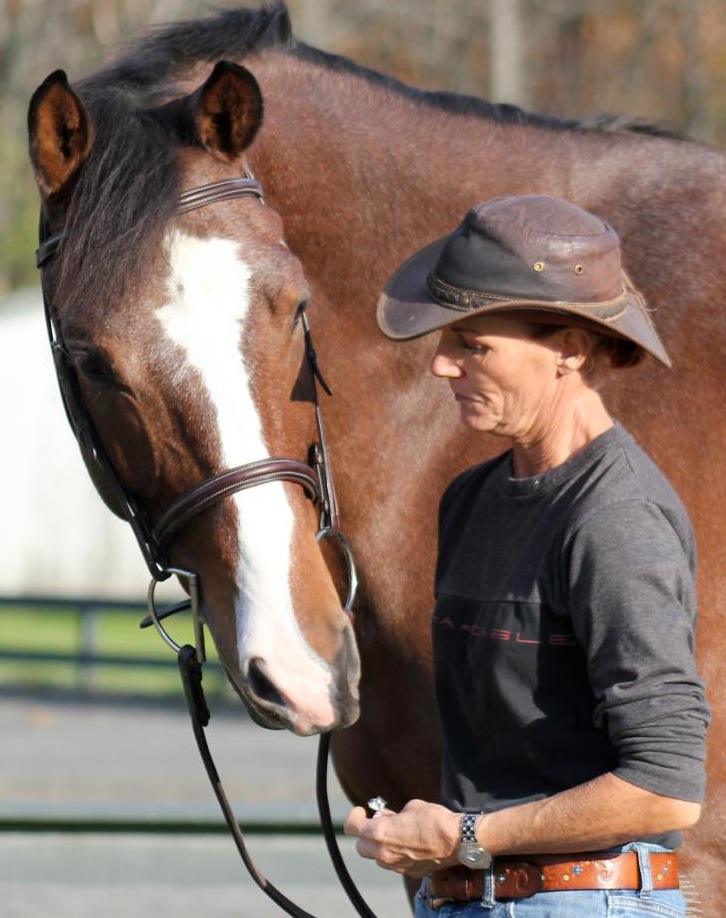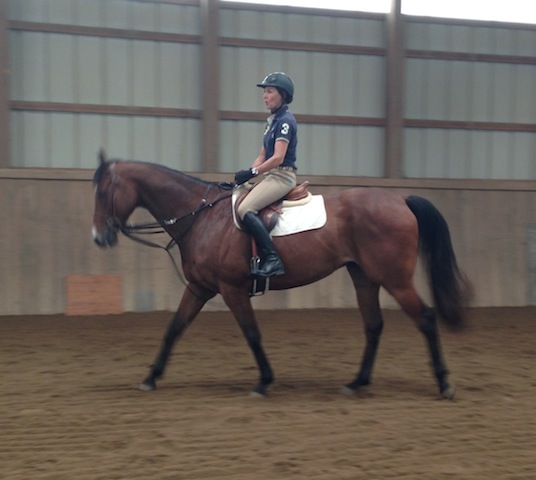There are no gimmicks that will turn a racehorse into a show horse. Like anything else worth doing, and doing well, it’s all about commitment, time, repetition, and above all, patience.
That’s why Tammy Hicock never promises the moon when her clients show up, all eager and bubbling with the high hopes for their brand new off-track Thoroughbred.
She settles them down right away.
Ask her what type of rider tends to be more suitable for an OTTB, and her reply often begins with the word patient. Ask what the best practices are in OTTB training, and there’s that word again — patience.
In this week’s Clubhouse Q&A, the California native who teaches hunter/jumper and equitation at Talyn Riding Academy at Twisdenwood Farm in Georgetown, Mass., discusses the OTTB under saddle. And why, despite the extra effort they sometimes require, they remain, hands- and hooves-down, her all-time favorites.
Q: You have a long history riding OTTBs.
I’m a native Californian, and we bought them straight off the track at Santa Anita. We’d get them and bring them along for the show ring. That’s all I rode, growing up, and OTTBs are my passion.
Q: Much as you love them, you don’t promise overnight success.
There’s a misperception that you can go buy a horse off the track, and it’s cheap, and that anybody can go grab one and have the right horse. What I tell people is that OTTBs need professional training, period. You will love your OTTB if you get the right training.
Q: Recognizing that there is no hard-fast rule for every horse, that they’re all different, requiring less or more training, is there an average amount of time required for re-training?
When you get a Thoroughbred off the track, you have to un-train him. In a sense, it’s like reprogramming t hem. They’re highly fine-tuned animals who are very sensitive to your emotions and environment. The best way to teach them is slowly, with a lot of repetition, on a daily basis.
Q: What are some of the typical no-nos that need to be un-taught?
These horses are bred for running and speed, so you typically need to teach them to trot slower, and straight. Our legs lay down on their sides, and we use them to guide the horse. At the racetracks, (by contrast) the jockeys just stand in the stirrups and the horses start running.
They also usually need to be taught not to pull on you. They’re taught to pull you, so you have to teach them by the repetition of pulling-and-yielding, so that they eventually understand it’s not OK to pull.
Q: Besides patience, what other qualities are necessary in an equestrian who wants to ride an OTTB?
Quiet hands, and a quiet seat. They should also be someone who isn’t going to expect miracles.
Q: What about the Thoroughbred temperament.
A Thoroughbred will give you the world, I think, once they understand what you want and why. You have to set guidelines for their behavior, and reinforce that, because they will test you. If I go into the ring and one starts trotting sideways, I have to explain that they can’t do that, by using all the tools in my toolbox to address that behavior. Thoroughbreds are very smart.
Q: Though some Thoroughbreds may require more dedicated training than other breeds, you think it’s worth it.
Yes! They have more heart and more drive than other breeds I’ve worked with, and their work ethic is amazing. They want to work for you, and they want to do it right. If I’m riding at 70 percent and I get on a Thoroughbred, they cover me; they bring 130 percent. If I’m riding a Warmblood, a breed I think is more laid back, and I go out at 70 percent, they’ll also work at 70 percent. They’re the worker bees!




Tammy is my trainer and has done an incredible job teaching my OTTB, What a Trippi, along with teaching me not just how to ride but how to communicate properly with my horse. I think this article should be a must read for anyone purchasing their first OTTB.
I bought an OTTB at auction, outbidding killers by $10. A pretty dark bay gelding with papers that told the sad story of 78 starts, underscored by big ocelets in his ankles.; some wins. About 2 days later, after taking him home, we started trail riding with other riders/horses. At first, we all just walked and a bit of a trot, and quietly returned home. After a few weeks, we were galloping, and even jumping coops – he was a marvelously talented and brave jumper! That fall, we went fox hunting, and had an absolute blast – he absolutely loved fox hunting – so keen that a little bit of tranquilizer was necessary to make him stand still while being mounted – then off we’d go. A great, smart, brave horse. Wish I still had him. Wish I could find another just like him
This article made me smile. My daughter has an OTTB and through patience, time and starting back at the beginning, her OTTB and her are a real team. My daughter does have quiet hands and a soft seat but mostly love and patience. I don’t think you will ever get her to own anything else!
Susan,
A lot of good information/perspective in the article along with the reader’s comments. As Loreen and the article point out, thoroughbreds are smart and they are thinkers. This is a great gift if utilized correctly or it can be a point of frustration for both rider and horse.
Ken Lian, DVM
It goes without saying that patience is something that should be employed when training any horse of any breed. It is especially important with the OTTB. If one is patient, normally one will be rewarded by a horse that will be a an eager and willing partner.
Susan, thanks to you and Tammy for providing this information.
“AMEN” so true this is, I run a 501(c)3 equine rescue , we take all breeds but working with the OTTB’s is my passion ! Not for most but when that person and animal “CLICK” and the horse begins to “Get it” (rider as well) NOTHING CAN BEAT THAT FEELING !!! OTTB’s WORTH IT !!!
There is nothing like an OTTB. I agree with everything Tammy stated. I’ve seen show barns “come home” with a new OTTB thinking they have their new hunter/jumper/dressage prospect and all too often the horse is gone in 4-6 weeks because “it wasn’t a good fit”. Under my breath I would say “wasn’t the right trainer”.
My mare is an OTTB who had lineage that kept her from slaughter, but she did bounce around a bit. When we finally got her you could tell she was tired of all of the different hands and trainings. I spent the first 2 months on the ground with her, then moved to the saddle. Lots of patience, lots of correct communication, and I now have an incredible horse. She can be as soft and willing as a trained golden retriever, or as whimsical and fast as her old race days, but knows exactly when she can do both.
I used to help break in trail horses when I was a teen. Mostly QH and Palomino’s. The brains are definitely wired differently in OTTB’s than any other horse. THEY ARE THINKERS. And when you have a thinker, you have to think, be patient and communicate correctly or it “won’t be a good fit”.
Excellent article. I do believe patience is the key to success in working with these exquisite animals! I find they teach me more than I, them. They become a part of you!
Can’t argue with a single statement in this great Q&A, Susan. I got my OTTB and all I knew about him was that he was greenbroke. Seller thought he was an appendix QH. At first, when I’d ask the horse for something and did not get it, I figured I was asking incorrectly. HE, on the other hand, wanted to make sure about what I was asking since he wanted to do the right thing the first time. We were the perfect match :o) I too love the breed and am glad there are trainers like Tammy Hickock who know how to bring out the best–probably in FAR less time than it took me to show “Huey” that his new life was going to be a tub of butter.
Awesome stuff. Tammy, the OTTB world needs more like you, and a handful of others.
Thanks, again, Sue.